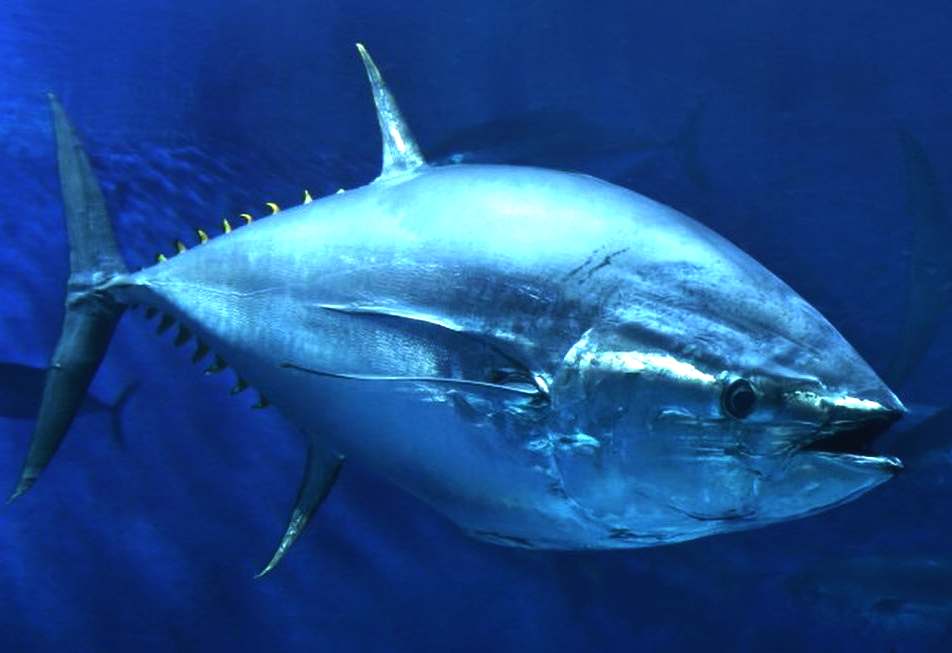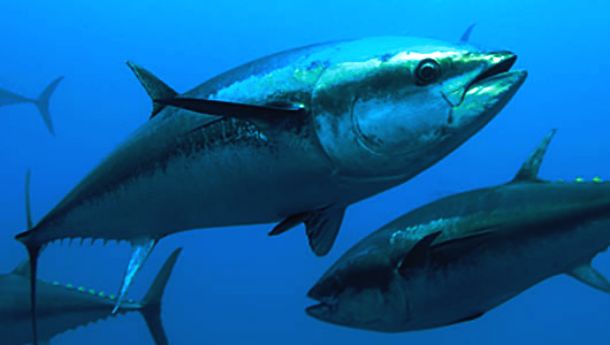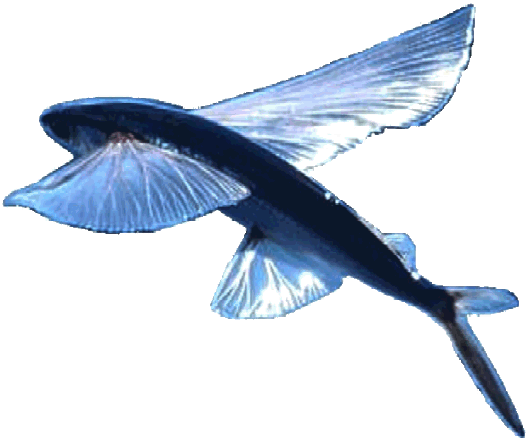|

A tuna is a saltwater finfish that belongs to the tribe Thunnini, a sub-grouping of the mackerel family (Scombridae) which together with the tunas, also includes the bonitos, mackerels, and Spanish mackerels. Thunnini comprises fifteen species across five
genera, the sizes of which vary greatly, ranging from the bullet tuna (max. length: 50 cm (1.6 ft), weight: 1.8 kg (4 lb)) up to the Atlantic bluefin tuna (max. length: 4.6 m (15 ft), weight: 684 kg (1,508 lb)). The bluefin averages 2 m (6.6 ft), and is believed to live for up to 50 years.
Their circulatory and respiratory systems are unique among fish, enabling them to maintain a body temperature higher than the surrounding water. An active and agile predator, the tuna has a sleek, streamlined body, and is among the fastest-swimming pelagic fish the yellowfin tuna, for example, is capable of speeds of up to 75 km/h (47 mph). Found in warm seas, it is extensively fished commercially and is popular as a game fish. As a result of over-fishing, stocks of some tuna species, such as the Southern bluefin tuna, have been reduced dangerously close to the point of extinction.
The tuna is a sleek and streamlined fish, adapted for speed. It has two closely spaced dorsal fins on its back; The first being "depressible" it can be laid down, flush, in a groove that runs along its back. Seven to 10 yellow finlets run from the dorsal fins to the tail, which is lunate curved like a crescent moon and tapered to pointy tips. The caudal peduncle, to which the tail is attached, is quite thin, with three stabilizing horizontal keels on each side. The tuna's dorsal side is generally a metallic dark blue, while the ventral side, or underside, is silvery or whitish, for camouflage.
FISHING INDUSTRY
Tuna is an important commercial fish. The International Seafood Sustainability Foundation (ISSF) compiled a detailed scientific report on the state of global tuna stocks in 2009, which includes regular updates. According to the ISSF, the most important species for commercial and recreational tuna fisheries are yellowfin (Thunnus albacares), bigeye (T. obesus), bluefin (T. thynnus, T. orientalis, and T. macoyii), albacore (T. alalunga), and skipjack (Katsuwonus pelamis).
The report further states:
Between 1940 and the mid-1960s, the annual world catch of the five principal market species of tunas rose from about 300 thousand tons to about 1 million tons, most of it taken by hook and line. With the development of purse-seine nets, now the predominant gear, catches have risen to more than 4 million tons annually during the last few years. Of these catches, about 68 percent are from the Pacific Ocean, 22 percent from the Indian Ocean, and the remaining 10 percent from the Atlantic Ocean and the Mediterranean Sea. Skipjack makes up about 60 percent of the catch, followed by yellowfin (24 percent), bigeye (10 percent), albacore (5 percent), and bluefin the remainder.
Purse-seines take about 62 percent of the world production, longline about 14 percent, pole and line about 11 percent, and a variety of other gears the remainder 3. The Australian government alleged in 2006 that Japan had illegally overfished southern bluefin by taking 12,000 to 20,000 tonnes per year instead of the their agreed 6,000 tonnes; the value of such overfishing would be as much as USD $2 billion. Such overfishing has severely damaged bluefin stocks. According to the WWF, "Japan's huge appetite for tuna will take the most sought-after stocks to the brink of commercial extinction unless fisheries agree on more rigid quotas".
Japan's Fisheries Research Agency counters that Australian and New Zealand tuna fishing companies under-report their total catches of southern bluefin tuna and ignore internationally mandated total allowable catch totals.
In recent years, opening day fish auctions at Tokyo's Tsukiji fish market have seen record-setting prices for bluefin tuna, reflecting market demand. In each of 2010, 2011, 2012 and 2013, new record prices have been set for a single fish the current record is 155.4 million japanese yen (US $1.76 million) for a 221 kg (490 lb) bluefin, or a unit price of JPĽ 703,167/kg (US$ 3,603/lb).
In November 2011, a different record was set when a fisherman in Massachusetts caught an 881-pound tuna. It was captured inadvertently using a dragnet. Due to the laws and restrictions on tuna fishing in the United States, federal authorities impounded the fish because it was not caught with a rod and reel. Because of the tuna's deteriorated condition as a result of the trawl net, the fish sold for just under $5,000.

CONSERVATION
There are five main tuna fishery management bodies: the Western Central Pacific Ocean Fisheries Commission, the Inter-American Tropical Tuna Commission, the Indian Ocean Tuna Commission, the International Commission for the Conservation of Atlantic Tunas and the Commission for the Conservation of Southern Bluefin Tuna. The five gathered for the first time in Kobe, Japan in January 2007. Environmental organizations made submissions on risks to fisheries and species. The meeting concluded with an action plan drafted by some 60 countries or areas. Concrete steps include issuing certificates of origin to prevent illegal fishing and greater transparency in the setting of regional fishing quotas. The delegates are scheduled to meet at another joint meeting in January or February 2009 in Europe.
In 2010, Greenpeace International has added the albacore, bigeye tuna, Pacific bluefin tuna, Atlantic bluefin tuna, southern bluefin tuna and the yellowfin tuna to its seafood red list. "The Greenpeace International seafood red list is a list of fish that are commonly sold in supermarkets around the world, and which have a very high risk of being sourced from unsustainable fisheries."
It is widely accepted that bluefin tuna have been severely overfished, with some stocks at risk of collapse. According to the International Seafood Sustainability Foundation (a global, non-profit partnership between the tuna industry, scientists, and the World Wide Fund for Nature), Indian Ocean yellowfin tuna, Pacific Ocean (eastern & western) bigeye tuna, and North Atlantic albacore tuna are all overfished. In April 2009, no stock of skipjack tuna (which makes up roughly 60 percent of all tuna fished worldwide) was considered to be overfished. However, the BBC documentary, South Pacific, which first aired in May 2009 stated that, should fishing in the Pacific continue at its current rate, populations of all tuna species could collapse within 5 years. It highlighted huge Japanese and European tuna fishing vessels, sent to the South Pacific international waters after overfishing their own fish stocks to the point of collapse.
A 2010 tuna fishery assessment report, released in January 2012 by the Secretariat of the Pacific Community (SPC), supported this finding, recommending that all tuna fishing should be reduced or limited to current levels and that limits on skipjack fishing be considered.

In
2007 it was predicted that bluefin tuna could disappear
completely from the Mediterranean.
In early May the Mediterranean bluefin tuna fishing season
starts again and a tragedy is about to unfold. The European
Union (EU) has set fishing quotas at more than twice what
science recommends and as a result the fishery is likely to
collapse.
In
an open letter (PDF format) WWF and concerned companies
across Europe are asking the EU to be reasonable.
WWF and these companies want a seafood industry that does not
destroy ocean life and are doing our bit to buy or sell
sustainable seafood. But we also want the EU to help by doing a
better job of managing fisheries in a sustainable way.
The EU must act now or risk presiding over the demise of one of
the most magnificent fish that swims the ocean.
http://panda.org//mediterranean/marine/bluefin_tuna/support_for_sustainable_seafood
POPULAR FISH:
Please
use the Index below to navigate the Animal Kingdom:-
|
AMPHIBIANS |
Such
as frogs (class: Amphibia) |
|
ANNELIDS |
As
in Earthworms (phyla: Annelida) |
|
ANTHROPOLOGY |
Neanderthals,
Homo Erectus (Extinct) |
|
ARACHNIDS |
Spiders
(class: Arachnida) |
|
BIRDS
|
Such
as Eagles, Albatross
(class: Aves) |
|
CETACEANS
|
such
as Whales
& Dolphins
( order:Cetacea) |
|
CRUSTACEANS |
such
as crabs (subphyla: Crustacea) |
|
DINOSAURS
|
Tyranosaurus
Rex,
Brontosaurus (Extinct) |
|
ECHINODERMS |
As
in Starfish (phyla: Echinodermata) |
|
FISH
|
Sharks,
Tuna (group: Pisces) |
|
HUMANS
-
MAN |
Homo
Sapiens THE
BRAIN |
|
INSECTS |
Ants,
(subphyla: Uniramia class: Insecta) |
|
LIFE
ON EARTH
|
Which
includes PLANTS
non- animal life |
|
MAMMALS
|
Warm
blooded animals (class: Mammalia) |
|
MARSUPIALS |
Such
as Kangaroos
(order: Marsupialia) |
|
MOLLUSKS |
Such
as octopus (phyla: Mollusca) |
|
PLANTS |
Trees
- |
|
PRIMATES |
Gorillas,
Chimpanzees
(order: Primates) |
|
REPTILES |
As
in Crocodiles,
Snakes (class: Reptilia) |
|
RODENTS |
such
as Rats, Mice (order: Rodentia) |
|
SIMPLE
LIFE FORMS
|
As
in Amoeba, plankton (phyla: protozoa) |
|
|
LINKS
http://en.wikipedia.org/wiki/Piranha
http://en.wikipedia.org/wiki/Flying_fish
http://en.wikipedia.org/wiki/Barracuda
https://en.wikipedia.org/wiki/Manta_ray
http://en.wikipedia.org/wiki/Bluefish
http://en.wikipedia.org/wiki/Tuna

|


